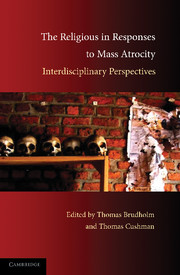Book contents
- Frontmatter
- Contents
- List of Contributors
- Acknowledgments
- Introduction: The Religious in Responses to Mass Atrocity
- Part I Between Necessity and Impossibility: The Role of Religion in the Face of Atrocity
- 1 Religious Rhetoric in Responses to Atrocity
- 2 The Limit of Ethics – The Ethics of the Limit
- 3 The Intolerability of Meaning: Myth, Faith, and Reason in Philosophical Responses to Moral Atrocity
- Part II Does It Help to Import Religious Ideas: Reflections on Punishment, War, and Forgiveness
- Part III Sociologies of the Religious in Responses to Mass Atrocities
- Index
1 - Religious Rhetoric in Responses to Atrocity
Published online by Cambridge University Press: 01 September 2009
- Frontmatter
- Contents
- List of Contributors
- Acknowledgments
- Introduction: The Religious in Responses to Mass Atrocity
- Part I Between Necessity and Impossibility: The Role of Religion in the Face of Atrocity
- 1 Religious Rhetoric in Responses to Atrocity
- 2 The Limit of Ethics – The Ethics of the Limit
- 3 The Intolerability of Meaning: Myth, Faith, and Reason in Philosophical Responses to Moral Atrocity
- Part II Does It Help to Import Religious Ideas: Reflections on Punishment, War, and Forgiveness
- Part III Sociologies of the Religious in Responses to Mass Atrocities
- Index
Summary
Introduction
In the exploration of the religious in responses to atrocity, one key area of inquiry is that of language. How does religious language help or hinder our efforts to respond to atrocity? What does the use of religious language enable us to articulate? What does it silence? Are there better and worse ways of using religious language? And just what do we mean by the term “religious language?”
In order to respond to these questions, I will begin by looking at a double bind that often characterizes the effort to speak about atrocity, whether religious language is used or not. This double bind, which is experienced most acutely by survivors of atrocity, involves the sense that it is necessary to speak about what happened, but impossible to do so adequately. In response to this double bind, some individuals turn to religious language – for example, they use words with religious connotations, such as “sacred,” “martyr,” “the demonic” – and the way this language functions rhetorically influences whether it hinders or helps in the effort to respond to atrocity.
Drawing on writings about the Holocaust, I will discuss two of the ways that religious language can function in response to atrocity – apophatically and redemptively. These two ways do not exhaust the possibilities for how religious language can function, but they do stand at opposite ends of a spectrum of rhetorical functions.
- Type
- Chapter
- Information
- The Religious in Responses to Mass AtrocityInterdisciplinary Perspectives, pp. 21 - 37Publisher: Cambridge University PressPrint publication year: 2009
- 2
- Cited by



